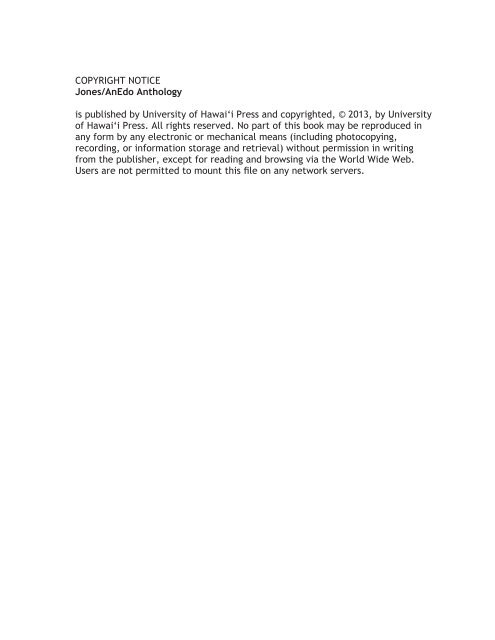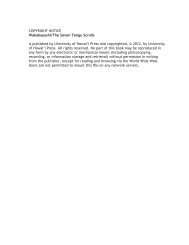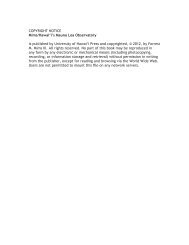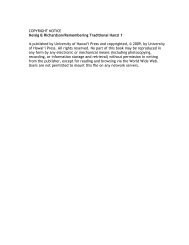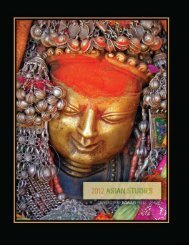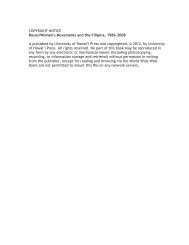The Monster Takes a Bride - University of Hawaii Press
The Monster Takes a Bride - University of Hawaii Press
The Monster Takes a Bride - University of Hawaii Press
You also want an ePaper? Increase the reach of your titles
YUMPU automatically turns print PDFs into web optimized ePapers that Google loves.
COPYRIGHT NOTICE<br />
Jones/AnEdo Anthology<br />
is published by <strong>University</strong> <strong>of</strong> Hawai‘i <strong>Press</strong> and copyrighted, © 2013, by <strong>University</strong><br />
<strong>of</strong> Hawai‘i <strong>Press</strong>. All rights reserved. No part <strong>of</strong> this book may be reproduced in<br />
any form by any electronic or mechanical means (including photocopying,<br />
recording, or information storage and retrieval) without permission in writing<br />
from the publisher, except for reading and browsing via the World Wide Web.<br />
Users are not permitted to mount this file on any network servers.
GHOSTS, MONSTERS, AND DEITIES 137<br />
<br />
JIPPENSHA IKKU<br />
Illustrated by Katsukawa Shun’ei<br />
<strong>The</strong> <strong>Monster</strong> <strong>Takes</strong> a <strong>Bride</strong> (Bakemono no Yomeiri, 1807) is an<br />
Z<br />
illustrated comic tale in which traditional marriage customs<br />
are reinvented in the context <strong>of</strong> a monster world. During the<br />
Edo period, weddings were <strong>of</strong>ten elaborate rituals marking the<br />
union <strong>of</strong> two families. Picture books from the eighteenth century used personified<br />
animals such as mice or foxes to act out the various stages in the<br />
marriage process. <strong>The</strong>se stories followed a set format. First the matchmaker<br />
introduces the two parties and arranges a meeting for the prospective<br />
bride and groom. Next come the exchange <strong>of</strong> betrothal presents and the<br />
assembling <strong>of</strong> the dowry. <strong>The</strong> actual wedding consists <strong>of</strong> the bridal procession<br />
by palanquin to the groom’s house, and the subsequent ceremony and<br />
banquet. In the days after the wedding, friends and relatives pay their respects<br />
to the new bride. <strong>The</strong> stories end with the birth <strong>of</strong> the first child and<br />
traditional shrine visit. Apart from their entertainment value, such picture<br />
books may have served as manuals for young girls approaching marriageable<br />
age.<br />
While <strong>The</strong> <strong>Monster</strong> <strong>Takes</strong> a <strong>Bride</strong> remains faithful to the framework <strong>of</strong><br />
these “marriage manuals,” the grotesque nature <strong>of</strong> the monsters themselves<br />
lends a comic twist to the pattern. <strong>Monster</strong> stories were a popular genre in<br />
the earliest illustrated books (kusazōshi). Supernatural creatures <strong>of</strong> all varieties<br />
(collectively known as bakemono or yōkai) abound in Japanese myth<br />
and legend, and these early books written mainly for children were <strong>of</strong>ten<br />
an illustrated retelling <strong>of</strong> traditional tales. Many <strong>of</strong> the stories centered<br />
on the stalwart warriors who were dispatched to conquer these menacing<br />
creatures.<br />
With the advent <strong>of</strong> “yellow books” (kibyōshi) in the late 1770s, monsters<br />
took on a new identity as part <strong>of</strong> a sophisticated urban culture. <strong>Monster</strong>s<br />
appearing in books, plays, woodblock prints, children’s toys, and<br />
sideshow attractions were seen more as objects <strong>of</strong> entertainment than as<br />
genuinely scary. In addition to creatures found in legend, new monsters<br />
were being artificially created specifically as commodities for the urban<br />
audience.<br />
<strong>The</strong> humor in the “yellow book” monster stories is multifaceted. First,<br />
there are the monsters themselves—a motley assortment <strong>of</strong> one-eyed or<br />
long-necked creatures; beings part human, part animal; grotesque parodies<br />
<strong>of</strong> sexual organs; or personified household objects busily performing
138 GHOSTS, MONSTERS, AND DEITIES<br />
their daily tasks. <strong>The</strong>se monsters were no longer intent on scaring humans.<br />
Following a popular saying <strong>of</strong> the time that only country bumpkins and<br />
monsters live beyond the Edo borders, monsters had become synonymous<br />
with uncouth boors. But rather than accept their fate, these creatures would<br />
try to imitate the ways <strong>of</strong> the true Edo sophisticate. <strong>The</strong>ir efforts, <strong>of</strong> course,<br />
always ended in disaster, with the inevitable comic results.<br />
In <strong>The</strong> <strong>Monster</strong> <strong>Takes</strong> a <strong>Bride</strong>, there are no human characters. Here the<br />
monster world exists parallel to the human world, and the humor pivots<br />
on the reversal <strong>of</strong> traditional human values. For example, the prospective<br />
groom is excited to hear that his bride-to-be is unusually ugly. As for the<br />
bride, she is delighted by her future husband’s scraggly whiskers and scummy<br />
teeth. A brewing storm is perfect weather for the wedding day. During<br />
the reception banquet, the guests indulge themselves on such delicacies as<br />
human bones, while the chef throws away the meat. Although the work tells<br />
us much about wedding customs specific to Edo Japan, this kind <strong>of</strong> humor<br />
is both universal and timeless.<br />
<strong>The</strong> <strong>Monster</strong> <strong>Takes</strong> a <strong>Bride</strong> was published in the transitional year <strong>of</strong><br />
1807, when the humor-centered “yellow books” were replaced by the longer<br />
and more romance-oriented “combined volumes” (gōkan). Although<br />
this work technically belongs to the latter category, it is a typical “yellow<br />
book” in terms <strong>of</strong> its length, subject matter, and humor.<br />
Jippensha Ikku (1765–1831), <strong>of</strong>ten dubbed Japan’s first pr<strong>of</strong>essional<br />
writer (that is, the first writer to make a living solely from the income <strong>of</strong> his<br />
books), was born in Suruga Province (now Shizuoka Prefecture) and spent<br />
several years in Osaka as an apprentice jōruri playwright before moving to<br />
Edo in 1793. He is best known as the author <strong>of</strong> the Tōkaidō series Along<br />
the Tōkaidō Highway on Foot (volume one published in 1802, translated as<br />
Shank’s Mare), a comic novel recounting the rambunctious antics <strong>of</strong> two<br />
incorrigible Edoites on their journey by foot down the Tōkaidō road to Osaka.<br />
<strong>The</strong> work was an instant best-seller and spawned sequel after sequel, its<br />
travelogue format marvelously elastic. Long after Ikku’s death, a successor<br />
created a new Meiji version that took the descendants <strong>of</strong> these happy-golucky<br />
travelers as far away as London.<br />
Perhaps because he really did depend on the income from his books,<br />
Ikku was unusually prolific. In addition to the Tōkaidō series, he wrote literally<br />
hundreds <strong>of</strong> works in various genres. While this prodigious output inevitably<br />
suffers from repetition and sloppiness, Ikku had an instinctive grasp<br />
<strong>of</strong> what the public wanted. <strong>The</strong> Tōkaidō series was a perennial favorite well<br />
into the twentieth century, and even today Ikku’s writing has an appealing<br />
accessibility. <strong>The</strong> piece here is a perfect example <strong>of</strong> the kind <strong>of</strong> ingenuous<br />
humor in which Ikku excelled.
GHOSTS, MONSTERS, AND DEITIES 139<br />
Ikku <strong>of</strong>ten illustrated his early works, including many <strong>of</strong> his monster<br />
stories, but here the illustrations are by Katsukawa Shun’ei (1762–1819), an<br />
accomplished ukiyo-e artist <strong>of</strong> the Katsukawa School.<br />
( ak )<br />
translated by Adam Kabat<br />
<strong>The</strong> <strong>Monster</strong> <strong>Takes</strong> a <strong>Bride</strong>,<br />
illustrated by Katsukawa Shun’ei.<br />
university <strong>of</strong> tohoku library
140<br />
Autumn leaves glistening after<br />
a passing shower may recall<br />
the eerie lights in a foxes’<br />
bridal procession; a rice cake<br />
vanishing in the dark <strong>of</strong> night<br />
may well end up as a betrothal<br />
present for a mouse. Everyone<br />
knows <strong>of</strong> the “mice bride”<br />
and the “fox groom,” and in<br />
the old picture books you can<br />
find their stories. But who has<br />
heard <strong>of</strong> a “monster wedding?”<br />
All living things are born from<br />
the fusion <strong>of</strong> yin and yang.<br />
<strong>The</strong> long-necked monster<br />
ladies have an elegant charm;<br />
the snow queens a seductive<br />
beauty. And while it is said<br />
that ghosts exist only from the<br />
waist up, most ghosts go as far<br />
down as the knees: they have<br />
the part that really counts. My<br />
long association with monsters<br />
has made me an<br />
expert in such<br />
matters, and with<br />
that in mind, I<br />
take pen in hand.<br />
Jippensha Ikku<br />
New Year’s, <strong>The</strong><br />
Year <strong>of</strong> the Hare<br />
“You won’t find a monster or yokel anywhere<br />
in Edo” the old saying goes. Even so, there are<br />
the “one-eye monsters” on Mt. Atago who stare<br />
through the “one-eye” <strong>of</strong> their spyglass, and<br />
the “long-necked monsters” who stretch their<br />
necks impatiently as they wait for their favorite<br />
courtesan, bored by the company <strong>of</strong> some young<br />
apprentice. And art and poetry gatherings all<br />
over town are overflowing with “old bogies.” Why,<br />
these days it’s the human beings who are the real<br />
monsters. Even in the picture books, the honestto-god<br />
monsters are practically extinct, and if you<br />
want to find one <strong>of</strong> them, you may have to search<br />
far beyond the borders <strong>of</strong> Edo.<br />
Many, many years ago, Momonjī was a favorite<br />
monster among children. Today, his only daughter<br />
clings to her faded youth by wearing garish<br />
makeup and a bright kimono. That is to say, she<br />
has reached marriageable age monster-style and<br />
is now the talk <strong>of</strong> the town. Momonjī, hoping to<br />
find a good husband for his daughter, consults<br />
with the local matchmaker, Dr. Toad.<br />
DR. TOAD With<br />
those bewitching<br />
good looks, she<br />
can have her<br />
pick <strong>of</strong> a<br />
husband.<br />
Doctors <strong>of</strong>ten doubled as matchmakers, earning 10 percent <strong>of</strong> the dowry. <strong>The</strong><br />
matchmaker is a toad, a creature considered to be endowed with supernatural<br />
powers. <strong>The</strong> hirsute Momonjī (also known as momonga, a flying squirrel) and
141<br />
MOMONJĪ I’m counting on you to make a<br />
respectable match, and with that in mind,<br />
I’m <strong>of</strong>fering a house as dowry. I bought<br />
the house from Mr. Cat, thinking I’d retire<br />
there myself. <strong>The</strong> place cost me an arm<br />
and a leg, but it’s a purrfect location, just<br />
<strong>of</strong>f Cat Alley—an old, ramshackle hovel<br />
run over with weeds, why a dream house<br />
for any monster. And Mr. Cat has provided<br />
a guarantee that all cat burglars<br />
will be subject<br />
to haunting.<br />
MOMONJĪ’S DAUGHTER Oh, I’m<br />
so embarrassed.<br />
MRS. MOMONJĪ My daughter’s<br />
so reserved. I don’t want to see her<br />
badgered by her mother-in-law.<br />
his wife consult with the matchmaker. Momonjī evolved from a peek-a-boo game<br />
in which children hiding in sheets scared passersby by shouting “momonga.”
142<br />
<strong>The</strong>se days Dr. Toad has abandoned medicine for the more lucrative trades <strong>of</strong> real<br />
estate and matchmaking. Now it so happens that Mr. One-eye is looking for a match<br />
for his son. In the monster world, perfection is scorned upon. <strong>The</strong> men seek out<br />
brides with crooked mouths and<br />
bent noses, the filthier the better.<br />
MRS. ONE-EYE You know<br />
we’re not the domineering in-law<br />
types, even if my mouth does<br />
stretch to<br />
my ears.<br />
MR. ONE-EYE Once<br />
my son settles down, he’ll<br />
take over the business<br />
for me.<br />
One-eyed monsters, popular in Japanese folk tradition, are depicted here as<br />
sexual organs. <strong>The</strong> household objects are also monsters. An ashtray holds a pipe<br />
in one hand while reaching for a tobacco pouch with the other. While Dr. Toad
143<br />
One-eye’s son has especially high standards, so when he hears just how hideous<br />
Momonjī’s daughter is, he insists on meeting her.<br />
ONE-EYE’S SON I<br />
can’t wait to see what<br />
she looks like!<br />
DR. TOAD She’s a<br />
monster through and<br />
through with not one<br />
feature to recommend<br />
her. <strong>The</strong> ideal bride.<br />
consults with Mr. and Mrs. One-eye, their son listens in attentively. <strong>The</strong> hibachi<br />
<strong>of</strong>fers Dr. Toad a cup <strong>of</strong> tea.


